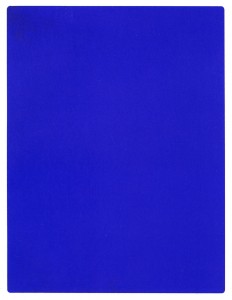Neo-Dada and Pop Art
Neo-Dada is an avante-garde movement (generally restricted to the visual arts) that emerged in the 50’s and 60’s out of the ashes of its better-known predecessor, Dada. Dada, of course, is known for its smashing of previous aesthetic boundaries (the famous example is “The Scream”, which is probably unnecessary to describe, thanks to several bad horror movies). Neo-Dada takes this progressivism a step further with even more modern materials and absurd depictions. It also references popular culture. Yves Klein is among the artists considered neo-dadaist. The following illustration is one of his monochromes.
Perhaps a better known movement is one directly inspired by neo-dada, many of whose pioneers are also considered neo-dadaists. While Dada had a decidedly dark sense of humor, and revolved around aesthetic anarchy, satire, and an antiestablishment anti-art message, pop-art embraced mainstream culture (hence the name) and sought to cast it in an artistic mold. It is not an easily accessible form of art; the average viewer may be confused by it. Marcel Duchamp (whose kinetic art is illustrated by an earlier post) is considered an early pioneer of pop-art. Perhaps the most famous representative of the genre is Andy Warhol, whose style is now well-known among the younger generation thanks to a Photobooth option on Apple computers which imitates one of his inventions. The following image is representative both of pop-art (perhaps the last movement of the modern period, soon to share the stage with post-modern movements in the sixties and onward) and of Warhol.
Harrison, Sylvia (2001-08-27). Pop Art and the Origins of Post-Modernism. Cambridge University Press.
http://www.yvesklein.com/
http://www.ralphmag.org/AR/dada.html — this is a translation of the DADA manifesto.
Comments
Leave a Reply
You must be logged in to post a comment.




